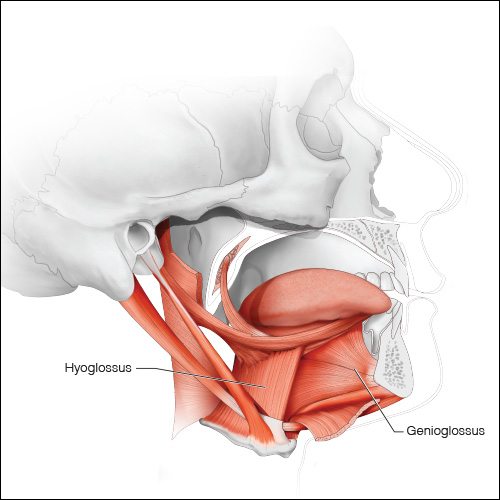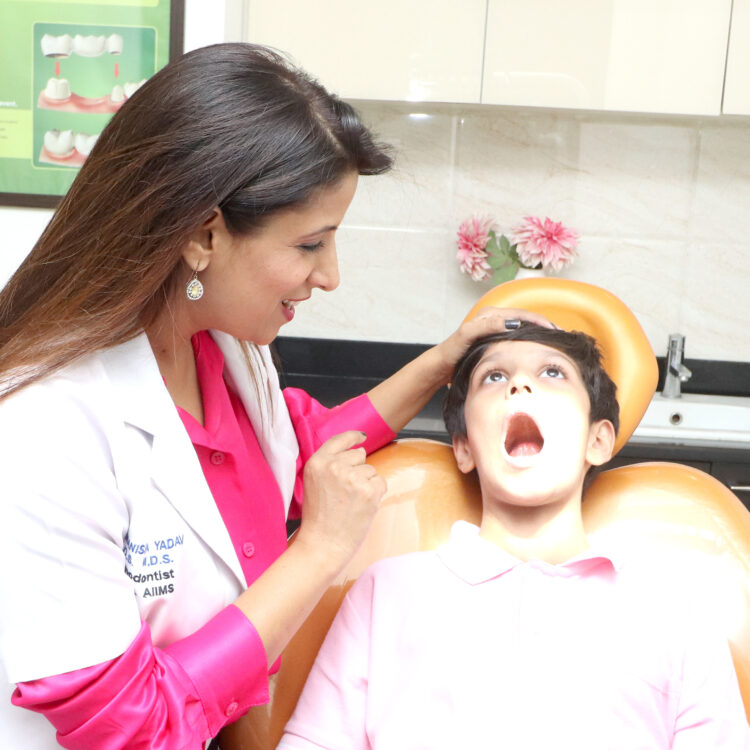Myofunctional therapy / tongue tie release

The tongue is a muscular organ consist of 8 muscles. Muscles of tongue are attached to upper and lower jaw and neck bones. Combined effort of all these muscles help in speaking, swallowing and also breathing.
Tongue is attached to the floor of the mouth with the help of tissue called lingual frenulum. In tongue tie or ankyloglossia this band of tissue is short, thick and tight restricting tongue’s basic functions depending on severity of tongue tie.

ROLE OF TONGUE
Tongue is very important muscle of our body, it is used in sucking, breast feeding, swallowing, drinking, eating, chewing, breathing, digestion, speech, jaw growth, overall facial development and posture of our head and neck.
Are you surprised to know so many functions of one simple tongue?
We are familiar that our bones are connected to our muscles and that helps in body movement but little it is ever mentioned about FASCIA. Fascia is very thin band of connective tissue that’s envelops our muscles.
Our deep front line fascia connects our tongue to our toes. That’s how a simple looking tongue tie can be the cause of problems in breathing, posture, pelvic floor stability and toe walking.
TONGUE CONNECTION TO OUR BODY
The tongue plays a fundamental role in several body functions such as swallowing, breathing, speaking, and chewing. Its action is not only confined to the oral cavity, but it also affects lower limb muscle strength and posture. The fascia beneath tongue extends to lungs, pelvic bone till feet. That is how tongue function affects orofacial function, diaphragmatic breathing and cervical posture.
Orofacial functions like chewing, swallowing, speech and breathing generate mechanical forces that helps in jaw achieve ideal growth to accommodate teeth in correct places. In other words,tongue which is resting at ideal position, helps in formation of nasal bone and thus initiates nasal breathing and normal development of jaw bones and happy orofacial muscles.A person resting his/her tongue at the bottom of the mouth can suffer from neck, jaw, and head pain, and overall body posture.
The anterior part of the tongue is important for non-respiratory activities, while the posterior part is important for respiration.
Muscles associated with tongue should be in good tonicity and must be well balanced, otherwise it results in alteration in position of hyoid bone ( floating bone in neck) and functionality of tongue.


A tongue tie can be a cause for sleep disordered breathing, which can cause sleep apnea, grinding/clenching of teeth and TMD , leading to headache, neck pain and shoulder pain. All these can be avoided or in cases corrected by correcting tongue tie.
In growing kids if tongue tie is corrected followed by myofunctional therapy, creates a good oral atmosphere for development of jaw bones. This further creates spaces for teeth to come in right position and further reduces chances of orthodontic treatment in later stages of life.
SYMPTOMS OF TONGUE TIE
In Children
-
Difficulty in breast feeding
-
Speech difficulties
-
Slow/picky eater
-
Mouth breather
-
Noisy breathing/ mild snoring
-
Frequent cold, cough & allergies
-
Sleep with mouth open
-
Grinding teeth at night
-
Daytime sleepiness
-
Hyperactive
-
Digestive problems like reflux, colic

In Adults
-
Mouth breathing
-
Noisy breathing/snoring
-
Deep palate
-
Crooked teeth
-
Open bite
-
Incorrect facial development
-
TMJ dysfunction
-
Headaches
-
Neck & shoulder pain
-
Sleep apnoea
-
Clenching/grinding teeth
-
Speech problems
-
Acid reflux
-
Tightness in chest
-
Tingling in calves & feet
DIAGNOSING TONGUE TIE
Tongue tie or restricted movement of tongue to perform its basic functions can be simple to severe. Tongue tie can be root cause to mouth breathing, constricted palate, crooked teeth, nasal bone malformation, malformed lower jaw, constricted airway, sleep apnea, clenching/ grinding teeth, TMD, headaches, neckaches, shoulder aches, poor body posture, sleep disordered breathing.
It’s a myth people consider only a tied tongue or a tongue which causes lisping is only tongue tie. A simple looking tongue which does not causes any lisping or problem in speech also can be a tongue tie. A comprehensive examination can detect whether patient has anterior, posterior or combined tongue tie.

TONGUE TIE RELATION TO TMD
Our tongue exerts due to tongue tie changes the breathing pattern, it allows child to breathe through mouth. A tongue tie person will have narrow maxilla (upper jaw) and lowered tongue posture which in return causes vertical facial growth. This impacts facial balance, beauty and function of child.
Tongue tie causes Mouth breathing which is early sign of sleep disordered breathing leading to snoring, clenching and sleep apnea.
A tongue tie leads to under developed jaw which in further leads to forward head posture, however this misaligns the alignment of spine and body.Patients suffering from TMD have fatigued muscles due to improper bite, improper breathing, trauma, stress, clenching/grinding. Jaw muscles overwork to compensate for keeping head posture and to increase breathing efficiency. These fatigued muscles radiate pain to head, neck, shoulder and spine.
Myofunctional therapy for TMD cases helps in enhancing and improving nasal breathing and improving tongue posture.
TREATING TONGUE TIE
After thorough history taking and clinical examination, treatment is decided depending on the severity whether it is anterior, posterior or combined tongue tie.
Frenectomy or frenuloplasty is minor surgical procedure done to loosen or remove tight band of tissue which is causing restricted tongue function.

WHY COME TO 32 DENTAL SOLUTIONS?
We at 32 Dental Solutions, believe in holistic treatment of the patient as the habits developed in childhood translates to problems later in life. Our Airway orthodontist Dr. Manisha Yadav believes in training the muscles of the face to act in their correct physiological way. The corrected muscle then can keep teeth and jaw in alignment as child grows. In many cases it eliminates the need of future orthodontic/braces treatment.as the main aim is to create room for teeth and tongue.
To keep this approach myofunctional therapy starts before tongue tie release and later after surgery, tongue is guided and taught proper functioning with help of myofunctional therapy. Myofunctional therapy is highly effective physical therapy exercises aim to improve breathing, swallowing, posture and bite.













